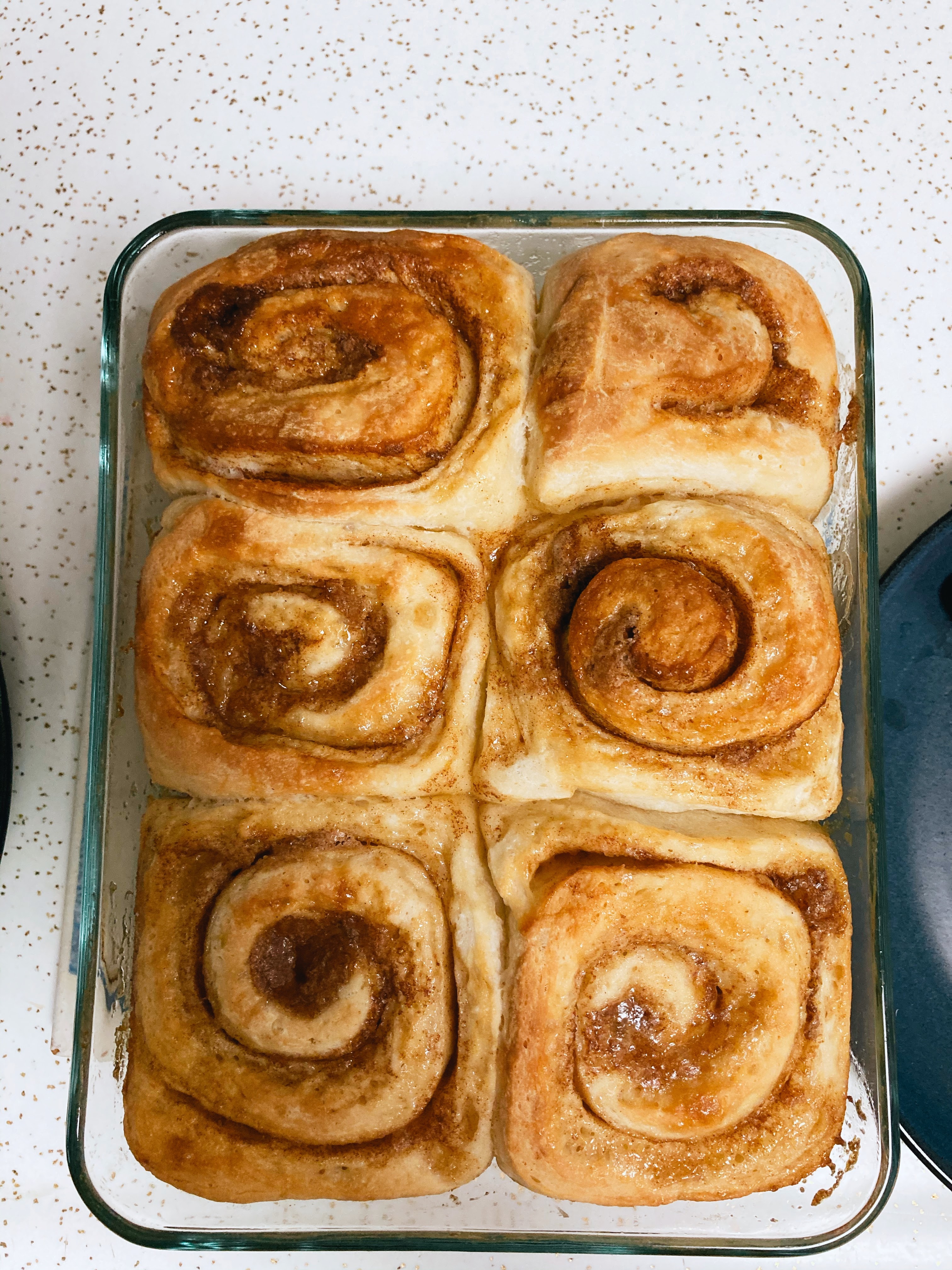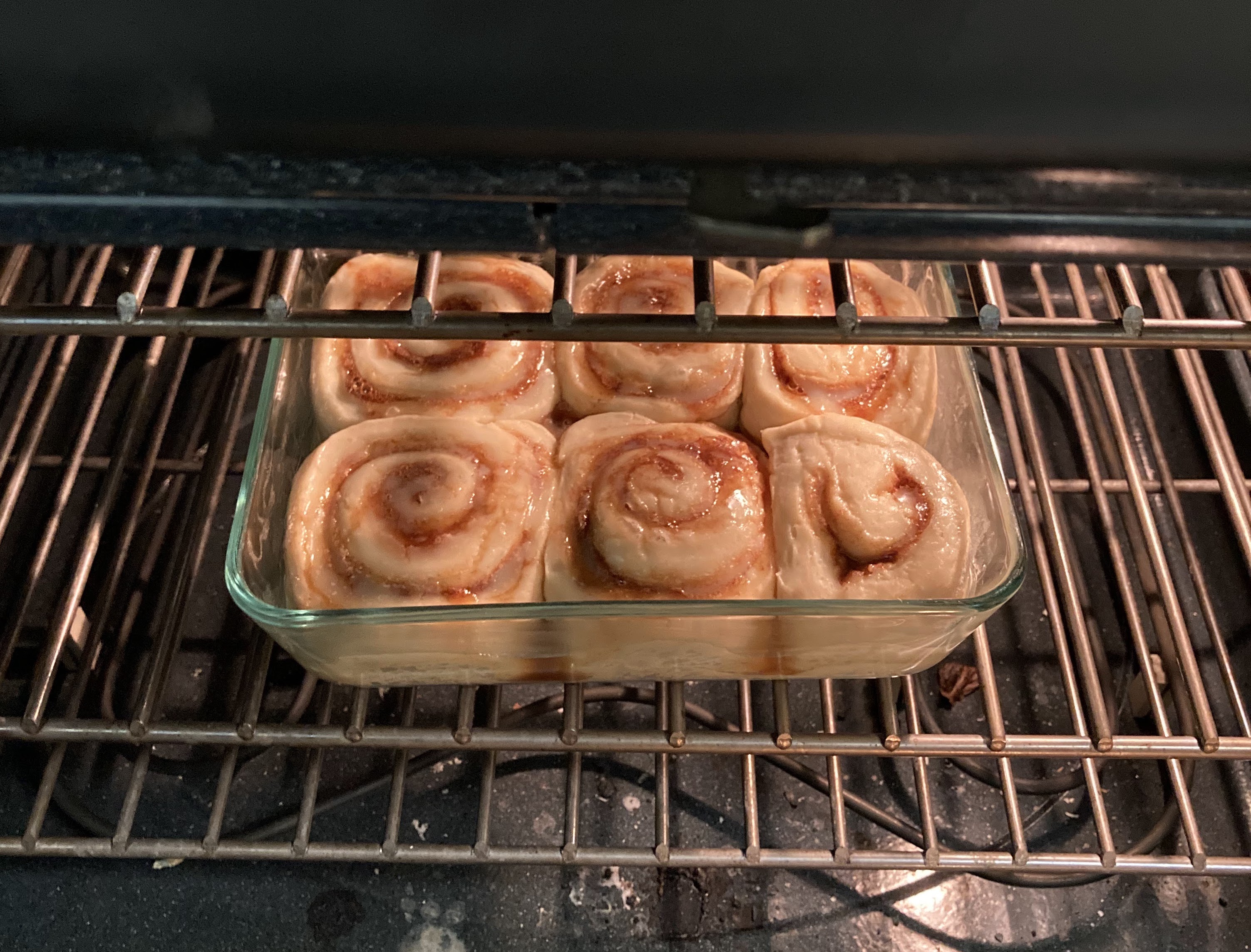Content from Sourdough Cinnamon Roll Introduction
Last updated on 2024-11-19 | Edit this page
Overview
Questions
- Why should you make sourdough cinnamon rolls?
Objectives
- Describe the overall appeal of sourdough cinnamon rolls
- Understand if this is the right recipe for you
Key Points
- Sourdough adds a distinct, slightly tangy and fruity flavor that elevates the traditional cinnamon roll.
- This recipe requires a bit more time and effort compared to conventional yeast-based recipes.
- Having an active sourdough starter is essential for this recipe.
We will be describing Little Spoon Farm’s delicious sourdough cinnamon roll recipe. The sourdough imparts a slightly tangy, fruity quality that complements the cinnamon flavor of the rolls. However, it does take slightly more work and time than a standard cinnamon roll recipe that uses dry yeast. Additionally, you’ll need to have some sourdough starter already going; alternatively, you can pester a friend for some of theirs, or make your own.

Callout
WARNING FOR GLUTEN SENSITIVE INDIVIDUALS: Note that this recipe uses wheat flour. Make sure to research alternatives to wheat flour for your own cinnamon rolls.
Content from Cinnamon Roll Ingredients
Last updated on 2024-11-19 | Edit this page
Overview
Questions
- What are the ingredients needed for the cinnamon rolls?
Objectives
- Be able to put together your shopping list
- Convert between metric and imperial units, if necessary
- Double the recipe if you’re really hungry
Ingredients
There are 3 main components to this recipe: the main ingredients for the dough, the ingredients for the cinnamon-sugar filling, and the ingredients for the glaze.
Dough Ingredients
R
main_ingredients <- tribble(
~ingredient, ~amount_imperial, ~amount_grams,
"butter (cold)", "8 tablespoons", 113,
"all-purpose flour", "2 ½ cups", 300,
"sourdough starter discard", "⅓ cup", 100,
"buttermilk", "1 cup", 240,
"honey or granulated sugar", "1 tbsp + 1 tsp", 25,
"fine sea salt", "¾ teaspoon", 4,
"baking powder", "1 tsp", NA,
"baking soda", "½ cup", NA)
main_ingredients %>%
kableExtra::kable(align = "r")
| ingredient | amount_imperial | amount_grams |
|---|---|---|
| butter (cold) | 8 tablespoons | 113 |
| all-purpose flour | 2 ½ cups | 300 |
| sourdough starter discard | ⅓ cup | 100 |
| buttermilk | 1 cup | 240 |
| honey or granulated sugar | 1 tbsp + 1 tsp | 25 |
| fine sea salt | ¾ teaspoon | 4 |
| baking powder | 1 tsp | NA |
| baking soda | ½ cup | NA |
Callout
Recipe modifications:
You can use active sourdough starter instead of discard, if you so choose. There will be a slight modification to the recipe if that is the case.
In warmer climates, you may want to reduce the amount of buttermilk and/or increase the amount of flour to produce a less sticky, more manageable dough. You may have to experiment a bit.
Cinnamon-sugar filling
R
filling_ingredients <- tribble(
~ingredient, ~amount_imperial, ~amount_grams,
"light brown sugar", "¾ cup", 150,
"ground cinnamon", "2 teaspoons", NA,
"butter (melted)", "4 tablespoons", 56)
filling_ingredients %>%
kableExtra::kable(align = "r")
| ingredient | amount_imperial | amount_grams |
|---|---|---|
| light brown sugar | ¾ cup | 150 |
| ground cinnamon | 2 teaspoons | NA |
| butter (melted) | 4 tablespoons | 56 |
Glaze
R
glaze_ingredients <- tribble(
~ingredient, ~amount_imperial, ~amount_grams,
"powdered sugar", "1 cup", 120,
"butter (melted)", "1 tablespoon", 14,
"vanilla extract", "1 teaspoon", 5,
"milk", "2 tablespoons", 30)
glaze_ingredients %>%
kableExtra::kable(align = "r")
| ingredient | amount_imperial | amount_grams |
|---|---|---|
| powdered sugar | 1 cup | 120 |
| butter (melted) | 1 tablespoon | 14 |
| vanilla extract | 1 teaspoon | 5 |
| milk | 2 tablespoons | 30 |
Challenge
Add a column to main_ingredients that has the amount in
ounces (weight, not fluid oz).
R
main_ingredients <- main_ingredients %>%
mutate(amount_oz = amount_grams * 0.035274)
main_ingredients
OUTPUT
# A tibble: 8 × 4
ingredient amount_imperial amount_grams amount_oz
<chr> <chr> <dbl> <dbl>
1 butter (cold) 8 tablespoons 113 3.99
2 all-purpose flour 2 ½ cups 300 10.6
3 sourdough starter discard ⅓ cup 100 3.53
4 buttermilk 1 cup 240 8.47
5 honey or granulated sugar 1 tbsp + 1 tsp 25 0.882
6 fine sea salt ¾ teaspoon 4 0.141
7 baking powder 1 tsp NA NA
8 baking soda ½ cup NA NA Key Points
- Prepare your ingredients carefully in advance
- You will need to make adjustments if you are using active sourdough started instead of discard
Content from Baking Instructions
Last updated on 2024-11-19 | Edit this page
Overview
Questions
- How do you prepare the sourdough cinnamon rolls?
Objectives
- Be able to produce a batch of delicious cinnamon rolls
- Understand how to adjust proofing time
The Night Before
Mix the dough:
- Use a box grater to shred the cold butter into a large mixing bowl.
- Add the flour to the bowl and use a fork, bench scraper, or pastry cutter (if you have one) to cut the butter into the flour.
- Add the sourdough starter discard, buttermilk, honey and salt.
- Use a spatula or wooden spoon to mix until the ingredients are well incorporated.
- Cover the bowl and let it rest for 10-12 hours, depending on the temperature of your kitchen (more time for cooler kitchens, less time for warmer ones).
The Next Morning
Make cinnamon sugar filling and glaze:
- Mix the brown sugar and cinnamon in a small bowl.
- In a separate bowl, mix the glaze ingredients.
- Preheat oven to 375°F (290°C) and butter a 12” cast iron skillet or deep baking container (glass or enamel will work just fine).
Add leavening agents to dough:
If using active sourdough starter, skip this step.
- Use a fork to mix the baking powder and baking soda in a small bowl until they are evenly mixed with no clumps.
- Sprinkle the mixture evenly on top of the dough and use your hands to mix it in, distributing it evenly throughout the dough.
Roll out the dough:
- Flour your work surface generously and tip the dough out of the bowl onto it.
- Sprinkle flour across the top of the dough.
- Use a rolling pin to roll the dough into a roughly 12” x 24” (30cm x 61cm) rectangle, which should be about 1/4” (0.5cm) thick.
Cut out rolls:
- Use a pastry brush to coat the top of the dough with melted butter. If you don’t have a pastry brush, you can drizzle it and use a finger to spread it somewhat evenly.
- Sprinkle the cinnamon-sugar mixture evenly over the surface of the rolls so that it sticks to the melted butter, leaving a half inch (1cm) bare along the edges.
- Starting on one of the long sides of the rectangle, roll the dough into a log shape, so the log is about 24” (61cm) long
- Use the bench scraper or a knife to cut the log into 12 pieces, approximately 2 inches (5cm) long.
- Arrange the pieces in the baking vessel so the “swirls” are upright, leaving space in between each piece so they can expand while baking.
Callout
You may freeze the rolls after they are cut out and placed in a pan and bake directly. Be careful if your baking vessel is glass! You may instead want to place into a metal baking vessel before freezing.
Bake:
- Bake the cinnamon rolls for 35-40 minutes or until the tops show a nice golden-brown color.
- Remove from the oven and drizzle glaze over the rolls while they are still hot.
 A batch of cinnamon rolls partway through baking, wafting a very
tempting aroma throughout the kitchen.
A batch of cinnamon rolls partway through baking, wafting a very
tempting aroma throughout the kitchen.
